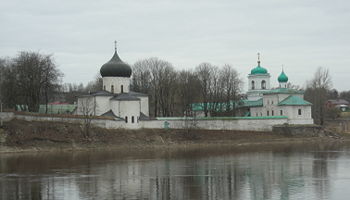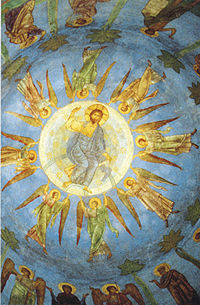Mirozhsky Monastery (Pskov, Russia)
The Mirozhsky Monastery, in Pskov, Russia, is an important Orthodox monastery of medieval origins that is famous for its twelfth century frescos in the monastery’s Transfiguration Cathedral.
Traditionally, Mirozhsky Monastery was founded in the twelfth century, but it may have been established as early as the early 1010s based on a manuscript bearing a thanksgiving list inscription mentioning Prince Svyatopolk of Kiev who was excommunicated from the Church in 1015 for the murder of his brothers, Boris and Gleb. The monastery soon became one of the richest monasteries in Pskov as well as a significant cultural center. It is located on the left bank of the Velikaya River where it meets the smaller Mirozhka River. The oldest building of the monastery is the Cathedral of the Transfiguration of Our Lord commissioned in the late 1130s by Archbishop Nifont of Novgorod when he was in exile from Novgorod. The cathedral is in the typical cross form of Greek churches. The frescos of the Transfiguration Cathedral were painted by artists from Constantinople in mid-twelfth century. Some eighty percent of these frescos have survived the ravages of flooding by the adjacent Velikaya River. Currently, the cathedral is part of the Pskov State Museum-Reserve of History, Architecture, and Art. The cathedral and its frescos are included on the UNESCO list of outstanding architectural landmarks of the world. A second church, the Church St Stephan the Archdeacon, was added to the monastery complex in the seventeenth century.
In those ancient times Christianity existed alongside paganism in the frontier around Pskov. Under Abp. Nifont’s leadership, the monastery became the center of an active evangelistic movement among the pagans in the Russian territories. In the monastery, new missionaries were trained in the ideals of Christianity. The monastery provided a place where the missionaries developed their preaching while practicing their personal examples of asceticism. Also in this early era the monastery was a center of chronicle writing.
The Mirozhsky Monastery was located outside the protective walls of Pskov, on the undefended side of the city. As a result, the monastery was easy prey for enemy forces approaching Pskov. In the winter of 1299, Livonian forces attacked the monastery, killing among others the monastery abbot Iosif, the writer of the Pskov chronicle. The monastery was again attacked by Livonians in 1323. In 1581, King Stephen Bathory of Poland used the monastery to bombard Pskov during his siege of the city. The Swedes occupied the monastery in 1615.
The monastery was closed by the Bolsheviks in 1922. In 1994, it was returned to the Russian Orthodox Church. Mirozhsky Monastery now supports the Pskov iconographic school, a teaching center for icon painters.
Sources
- V. Sarabianov, Transfiguration Cathedral of the Mirozh Monastery, Severny Polomnik, 2002 ISBN 5-94431-033-2
- Mirozhsky Monastery
- Pskov
- Monastery of Our Saviour’s Transfiguration (Pskov)

